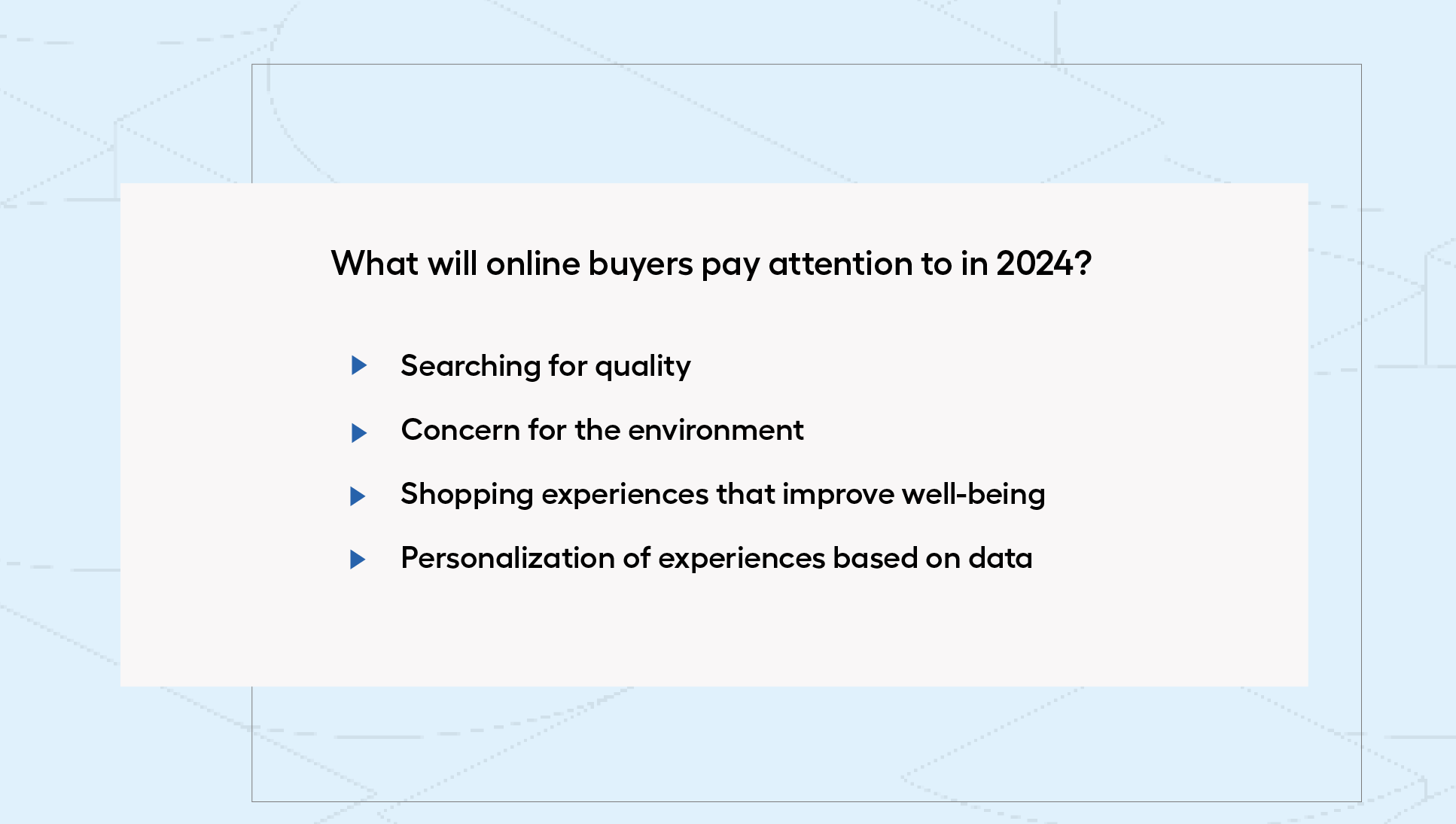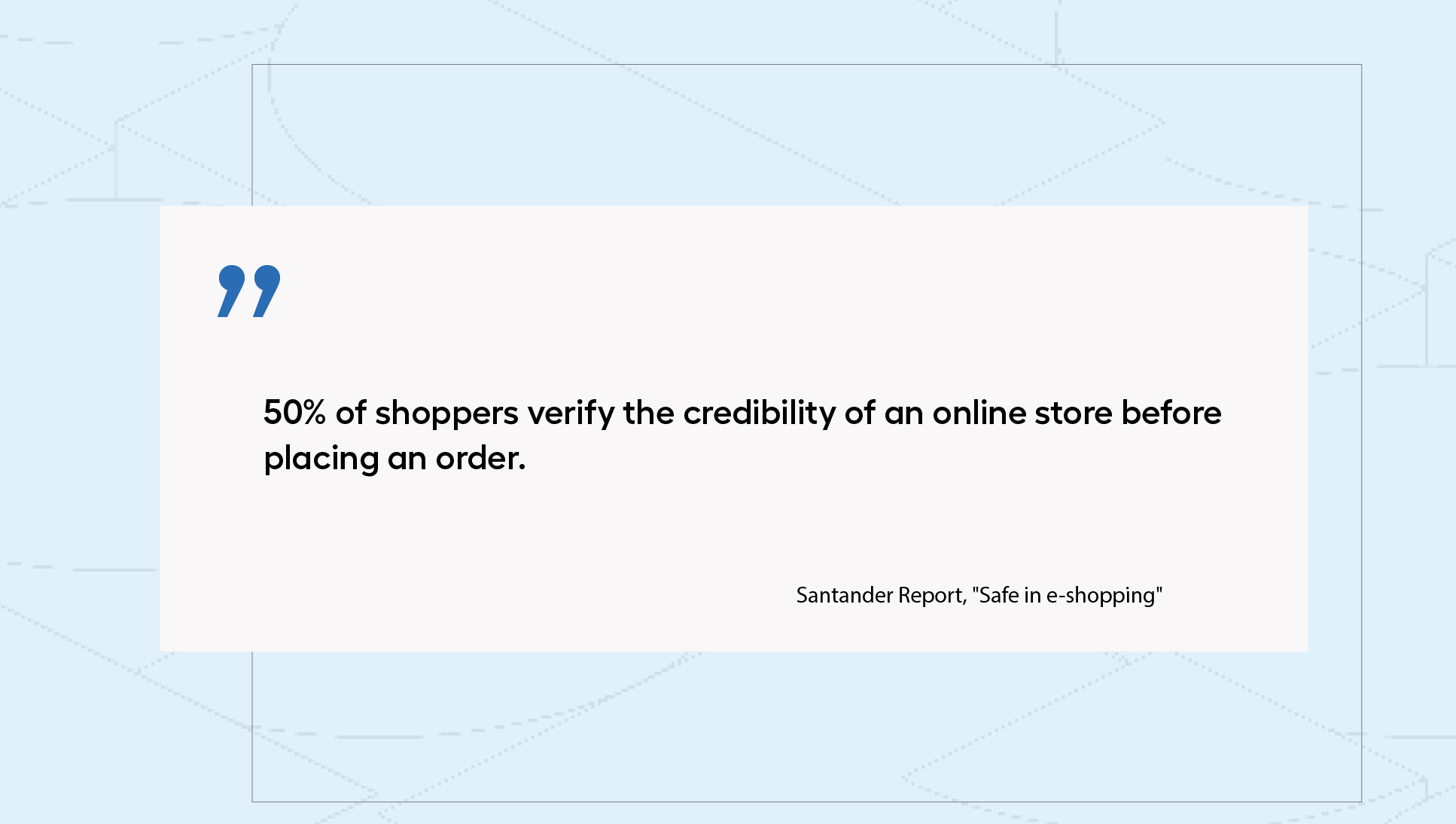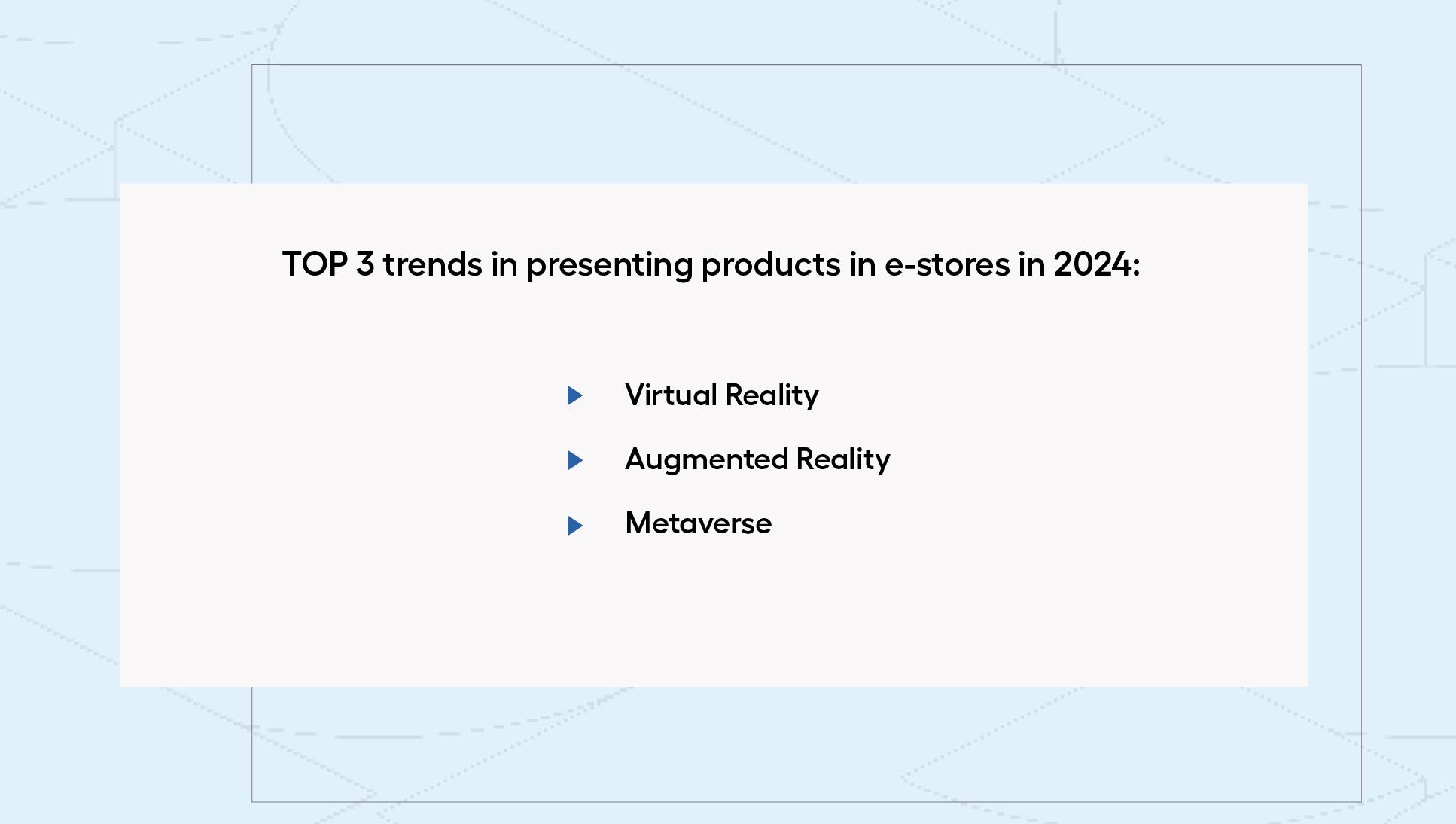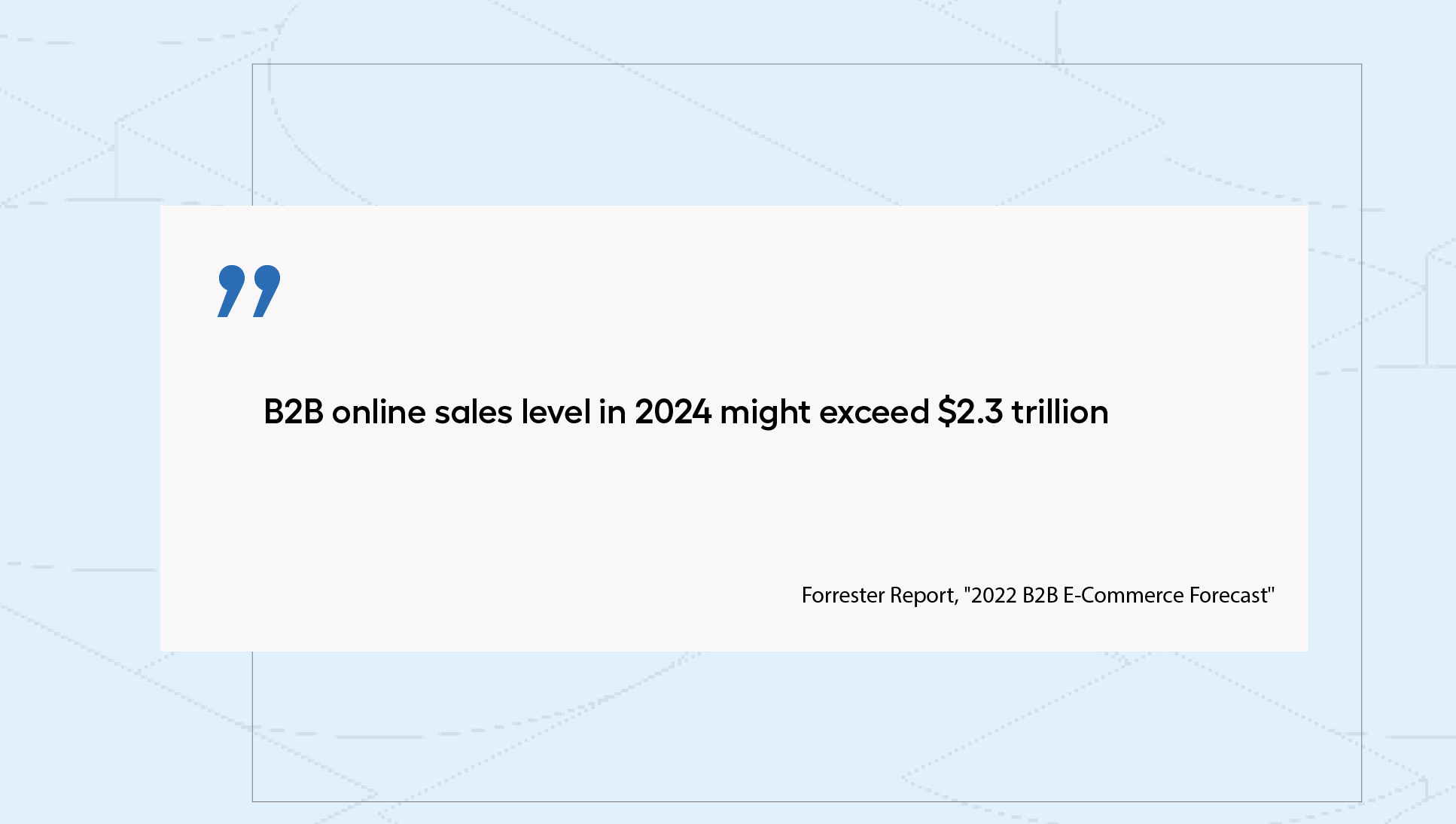Will the upcoming year revolutionize eCommerce? Key trends in eCommerce in 2024
In 2020 and 2021, when the world was taken by surprise by the coronavirus pandemic, the quick commerce market rapidly developed in the industry. A year later, deferred payments dominated online trading. Meanwhile, in 2023, it is impossible to talk about online sales without mentioning artificial intelligence. What will 2024 bring for the development of online stores? We examined market forecasts and presented the most important trends in this article. Are you curious about what the industry will be buzzing about in the coming months? Do you want to stay up-to-date with changes and outpace the competition? Read on and take a step into the future now!
Will 2024 be the year of eCommerce?
The eCommerce industry is constantly evolving, and with it, customer expectations are dynamically changing. Year after year, the behaviours of e-consumers are shaped by a series of trends (often related to the development of new technologies or even the economic situation). What will distinguish customers in 2024?
According to the "Must-watch consumer trends for 2024" report presented by Statista, shoppers in the coming year will be accompanied by 4 dominant ideas. These are:
- Quest for quality - in 2024, customers will emphasise quality over costs. High quality of products and services is a factor that increasingly determines the choices of buyers.
- Ethical spenders - sustainable development and concern for the environment are becoming important factors influencing the choice of products and online stores.
- Zenthusiasts - online shopping is not only a way to obtain necessary products but also a way to relax and relieve tension.
- Data ad-vocates - a new trend will also be the growing trust of consumers in sharing data for personalization of offers. "Data ad-vocates" are people ready to share their data in exchange for more personalised and tailored offers.

In the face of these trends, eCommerce in 2024 must respond to changing consumer expectations, delivering products and services that meet their needs in terms of quality, ethics, and personalization. To achieve this, sales platform owners will have to resort to innovative solutions. Find out what features and strategies you should implement in your online store now.
Safety first
Online security concerns are the first topic that will be significant for e-commerce in 2024. According to the Santander report titled "Safe in e-shopping," over 50% of shoppers verify the credibility of an online store before placing an order. Consumers most often pay attention to positive reviews but are also increasingly delving deep into safety matters, such as checking the validity of SSL certificates, compliance with regulations (including GDPR), and the security of the data provided (e.g., credit card numbers).

Moreover, customers are increasingly wary of potential threats associated with solutions generated by artificial intelligence (e.g., fake news or content created using deep fake technology). For this reason, having a transparent e-shop policy will be especially important in 2024 and the subsequent years. A responsible approach to security isn't just a technical issue - customer trust is foundational for effective sales. When shoppers feel secure, they are more inclined to make purchases and are more likely to recommend the online store to others.
Content revolution
Over time, trends change in fashion, interior industry and the design of everyday items. So, it's unsurprising that along with these shifts, new trends will also emerge in how content is presented on sales platforms. The way products are showcased in e-stores isn't just about aesthetics; it's primarily about creating positive and memorable user experiences. Therefore, in the eCommerce industry in 2024, one can expect a significant rise in the popularity of content using:
- Augmented Reality - AR has significantly affected the way consumers view products online. AR allows customers to "try on" products before purchasing, especially beneficial in the fashion and interior design sectors. Thanks to AR, users can see how a product will look in real life and determine if it meets their expectations. This approach not only enhances the shopping experience but also helps reduce the number of returns made.
- Virtual Reality - VR is consistently transforming the way customers experience online shopping. VR lets users "enter" virtual stores, browse products, and interactively explore the offerings. It's not just a more advanced shopping method but also a unique experience that sets a store apart from its competitors. A prime example of VR use is IKEA, which has developed a mobile app based on this technology. This allows customers to see how selected furniture looks in a real setting.
- Metaverse - a concept gaining increasing popularity in the eCommerce industry. The Metaverse is a virtual world where users can connect, use services, and make purchases. For online store owners, the Metaverse opens entirely new opportunities. Joining the Metaverse allows the creation of a virtual store accessible 24/7, where customers can meet and shop interactively. This revolutionary approach to eCommerce is currently being adopted by industry giants such as Nike, Coca-Cola, and Gucci due to the high costs and complexity of the technology.

A new perspective on product searching
Have you ever come across a product in a social media photo, but its name wasn't mentioned in the description? Or perhaps you simply don't have the time to search for specific phrases online to find the perfect product? In today's eCommerce reality, customers want to find products even faster and more conveniently. One of the dominant trends in 2024 will be alternative search forms. Online stores are increasingly supplementing traditional search engines with innovative methods, such as:
- Image search - the ability to find products using a photo taken with a smartphone or tablet is becoming the most convenient form of search for many. Users just need to upload a selected image, and the system, using machine learning algorithms, recognizes patterns and distinct features in the photo, suggesting similar products. For this functionality to work correctly, it's essential to ensure that product photos are of high quality, and their labels and descriptions are meticulously prepared so the system can effectively assist customers in finding what they're looking for.
- Voice commerce - this method shifts the way customers interact with stores. With simple voice commands, users can search for products, add them to the cart, check availability, and even make payments, all without touching a screen.
- Social media search - customers use social media platforms not only to share their photos and reviews of purchased products. According to Google, over 40% of young people more frequently use apps like TikTok to answer their queries (e.g., "Where to eat in town", "Which laptop is best for work") instead of traditional search engines. This means that as an online store owner, you must be active on social platforms and ensure that your products are easily accessible and identifiable, not just directly on your website.
Subscription models are back
You likely remember how, not so long ago, it was popular to buy books or magazines through a subscription. In this way, customers could, for a fixed fee, regularly (e.g. every month) receive a new copy of the product. Subscription models have also gained popularity in eCommerce. Why? Because purchases in this form allow for building customer loyalty, generating consistent revenue, and delivering personalised shopping experiences.
Introducing the option of online subscription purchases can serve both as the foundation of the business (e.g. in the case of streaming services or offering dietary catering), and also complement traditional sales. Alongside the standard offer, you can suggest that customers receive their favourite products (e.g. cosmetics, coffee, or video games) at predetermined intervals. Why consider this sales model in your eCommerce?
A well-thought-out subscription model primarily guarantees the delivery of additional value to customers. Through recurring purchases, buyers often get early access to new releases, personalised recommendations, or exclusive discounts. This approach helps build lasting relationships with customers and ensures future stability for the business.
B2B eCommerce has never been so popular
According to forecasts prepared by Forrester, in 2024, B2B online sales will exceed $2.3 trillion. By 2027, this amount might even reach $3 trillion. The above figures reflect the changing preferences of business customers. One of the key factors driving this growth is the increasing number of people from generations Y and Z (i.e. Millennials and Gen Z born after 1982) in the business market. As these groups gain professional experience, they assume more responsibility for making purchasing decisions in their companies. Unlike previous generations, Gen-Z and Millennials prefer to recognize the offerings and then make purchases online, often reducing traditional commercial interactions (e.g. face-to-face meetings or phone arrangements).

Recognizing these changes is essential to stay afloat in a changing business reality. Designing a B2B platform that meets the needs of contractors (i.e., taking into account individual price lists, placing bulk orders, or payments using trade credit) and business partners is an important step in building future strategies.
A step further, namely hyper-personalization
The trend of personalising shopping experiences, which is slowly becoming the standard in the online commerce industry, evolves in 2024 towards hyper-personalization. Contrary to the name, it doesn't mean creating complex and complicated functionalities. Quite the opposite. Hyper-personalization is based on precisely adjusting the shopping process to the individual needs and preferences of the customer. It's about caring for details that will make the buyer feel special. How to achieve such an effect?
Artificial intelligence and machine learning are the key technologies that drive hyper-personalization. AI-based algorithms analyse vast amounts of data to predict customer preferences and suggest products they are most likely interested in. These systems continuously learn from customer behaviours or previous purchase history. As a result, they can provide personalised recommendations (displayed on the homepage or in the shopping cart as part of upselling), increasing the chances of successful transactions and satisfied customers.
Resolution for 2024: success in eCommerce
The ability to try products in AR and VR, hyper-personalization, as well as sales in the subscription model - these are just some of the innovations that will change the face of electronic commerce. It's worth being prepared for these changes and implementing them in practice to offer customers unique shopping experiences and stand out from the competition. Which of the future trends will you implement in your eCommerce?



